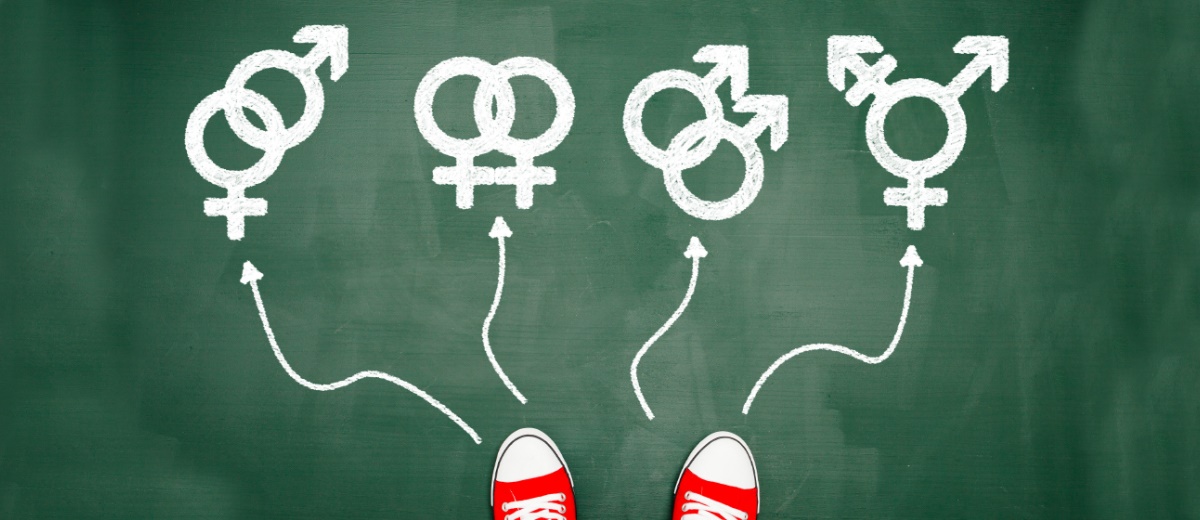Chances are that all classrooms include LGBTQ students. Although many aren't yet comfortable being open about their sexualities or gender identities, it is important to be prepared should you find yourself in a situation where a student has questions or needs support.
One way to demonstrate inclusive behavior and make conversations easier and more comfortable is by using the right terms. Always listen for and respect a person’s self-identified terminology.
In this installment we are updating and adding new terms to the glossary we published earlier this year to give you a comprehensive, up-to-date resource.
This list below was curated from Welcoming Schools, The Human Rights Campaign and The Pride Center at Lehigh University.
LGBTQ: Acronym for lesbian, gay, bisexual, transgender and queer.
Lesbian: People who love people of the same gender, specifically for women.
Gay: People who love people of the same gender.
Bisexual: A person who experiences sexual, romantic, physical, and/or spiritual attraction to people of their own gender as well as other genders, not necessarily at the same time, in the same way, or to the same degree.
Transgender: When your gender identity (how you feel) is different than what doctors/midwives assigned to you when you were born.
Queer: People use this word as a way to identify with and celebrate people of all gender identities and all the ways people love each other.
Heterosexual: People who identify as women who only love people who identify as men. And vice versa - people who identify as men who only love people who identify as women.
Pansexual: People who love people of any gender.
Sexual Orientation: Who you love or are attracted to.
Ally: A term used to describe someone who is actively supportive of LGBTQ people. It encompasses straight and cisgender allies, as well as those within the LGBTQ community who support each other (e.g., a lesbian who is an ally to the bisexual community).
Asexual: The lack of a sexual attraction or desire for other people.
Biphobia: The fear and hatred of, or discomfort with, people who love and are sexually attracted to more than one gender.
Cisgender: Someone who feels comfortable with the gender identity assigned to them based on their physical sex.
Demiromantic: A person who does not experience romantic attraction unless they form a strong emotional connection with someone.
Demisexual: A person who does not experience sexual attraction unless they form a strong emotional connection with someone. It's more commonly seen in but by no means confined to romantic relationships.
Discrimination: Prejudice + power. It occurs when members of a more powerful social group behave unjustly or cruelly to members of a less powerful social group. Discrimination can take many forms, including both individual acts of hatred or injustice and institutional denials of privileges normally accorded to other groups. Ongoing discrimination creates a climate of oppression for the affected group.
Gender Dysphoria (GD): Discomfort or distress caused by one’s assigned sex and the desire to change the characteristics that are the source.
Gender binary: A system in which gender is constructed into two strict categories of male or female. Gender identity is expected to align with the sex assigned at birth and gender expressions and roles fit traditional expectations.
Gender dysphoria: Clinically significant distress caused when a person's assigned birth gender is not the same as the one with which they identify.
Gender-expansive: A person with a wider, more flexible range of gender identity and/or expression than typically associated with the binary gender system. Often used as an umbrella term when referring to young people still exploring the possibilities of their gender expression and/or gender identity.
Gender expression: External appearance of one's gender identity, usually expressed through behavior, clothing, body characteristics or voice, and which may or may not conform to socially defined behaviors and characteristics typically associated with being either masculine or feminine.
Gender-fluid: A person who does not identify with a single fixed gender or has a fluid or unfixed gender identity.
Gender identity: One’s innermost concept of self as male, female, a blend of both or neither: how individuals perceive themselves and what they call themselves. One's gender identity can be the same or different from their sex assigned at birth.
Gender non-conforming: A broad term referring to people who do not behave in a way that conforms to the traditional expectations of their gender, or whose gender expression does not fit neatly into a category. While many also identify as transgender, not all gender non-conforming people do.
Genderqueer: Genderqueer people typically reject notions of static categories of gender and embrace a fluidity of gender identity and often, though not always, sexual orientation. People who identify as "genderqueer" may see themselves as being both male and female, neither male nor female or as falling completely outside these categories.
Intersex: Individual(s) born with the condition of having physical sex markers (genitals, hormones, gonads, or chromosomes) that are neither clearly male nor female. Intersex people are sometimes defined as having “ambiguous” genitalia.
Monosexual: Attracted to one gender. May be used for individuals who identify as straight, heterosexual, gay, lesbian, etc.
Nonmonosexual: Attracted to more than one gender. May be used for individuals who identify as queer, fluid, bisexual, pansexual, omnisexual, ambisexual, etc. Neutrois: A person who identifies as being neither male nor female. This differs from androgyne, in that an androgyne sees themselves as a mix of two genders and neutrois individual sees themselves as not having a gender. [Similar terms: genderless, agender, or nongendered.]
Non-binary: An adjective describing a person who does not identify exclusively as a man or a woman. Non-binary people may identify as being both a man and a woman, somewhere in between, or as falling completely outside these categories. While many also identify as transgender, not all non-binary people do. Non-binary can also be used as an umbrella term encompassing identities such as agender, bigender, genderqueer or gender-fluid.
TwoSpirit: A Native American term for people who blend the masculine and the feminine. It is commonly used to describe individuals who historically crossed gender. It is often used by contemporary LGBTQ Native American people to describe themselves.
Questioning: A term used to describe people who are in the process of exploring their sexual orientation or gender identity.
Shop MacGill’s selection of LGBTQ education materials and positive affirmation posters and signage!





